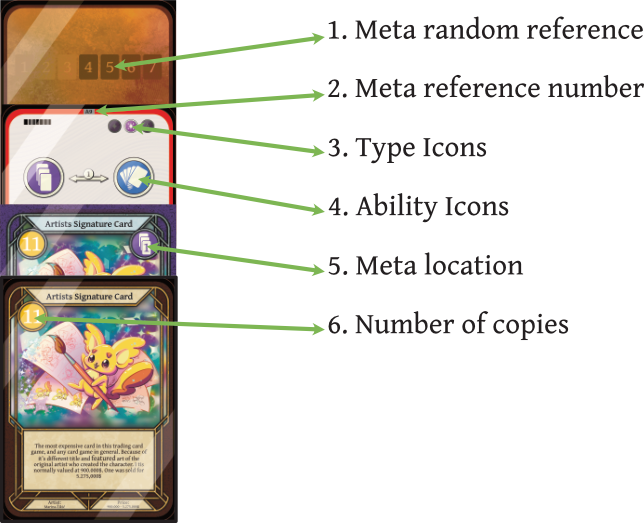CGT Rulebook
Welcome to Rules page for CGT. Watch the Rules video. More content will be added soon, both in text, and ability explanation in video form.

In CGT – Card game traders, players are collectors of extremely rare and valuable cards from various trading card games. During the game, the players will buy and play cards, changing their value depending on their availability (the current “Meta”). The goal is to manipulate the “Meta” in order to have the most valuable collection of cards at the end of the game.
On your turn, you’ll play (trade) a card from your hand (Collection), placing it on the appropriate Meta column, activate the ability of that column and, finally, buy cards from the Offer using their current value.
Contents:
7 Meta column marker cards
1 Meta Marker Card
1 Offer Marker Card
1 First player Marker Card
12 Ability Cards
4 Reference cards per Language
49 Game Cards in different quantities
There are 6 important parts of the Game, Meta and Ability Cards. Everything else is flavor and is irrelevant to the game.
1. Is used in random setup
2. is used in recommended setup on page 13
3. these show if an ability is active, passive or applicable during scoring
4. The Ability Icons
5. Position in Meta row
6. Represents the number of copies of the card in game, Meta card included. All cards with the same number are considered to be of the same “type”

Setup

Create Offer Row
Shuffle Game Cards to create the Deck.
Place the Deck at the top left corner of the play area.
Draw 6 cards from the Deck and place them face up in the Offer row (to the right of the Deck).
Cap the Offer Row with the Offer Marker card.
Create Offer Row
The back of the Ability Card shows their allowed placements in the Meta Column.
Using the Offer Row as a guide, draw and place 7 ability cards face up, below the Offer Row, from left to right, starting below the first face up card. When you draw an Ability Card, place it in the first empty column matching the allowed placement shown on its card back.
In case an Ability Card can’t be placed because all the allowed columns are occupied, place it at the bottom of the Ability Deck and draw a different card.
After filling each slot with one Ability Card, take the double sided Meta Column Markers and place them in Meta location order, on top of the ability cards, covering the bottom ability.
Note: You may want to check out some recommended setups in rulebook, page 13
Starting your Collection
Deal 5 cards to every player. Each player keeps two, passes two, and drops one.
Keeping cards: choose two cards to keep in your Collection.
Passing cards: choose two cards and pass one, to each adjacent player, face down. You are not allowed to look at the passed cards until all players are done keeping, passing, and dropping cards.
Dropping card: choose one card to place, face down, below Meta Row.
Once all players have chosen which cards to keep, pass and drop reveal all dropped cards and place them in their corresponding column in Meta Row.
Choosing the first player
The player that most recently initiated and completed a card trade is the first player, or the player is chosen in any other random way. First player takes First player Marker.
First player has a slight point penalty at the end of the game. Point penalty can be found on the First Player Marker.
Playing the Game
Gameplay starts with the first player and proceeds clockwise.
During the player’s turn they’ll: Trade a card, use the active ability of that card, if there’s any, and buy cards from the Offer Row.
Trading a Card: play a single card from your Collection and place it in the corresponding Meta column. Playing a card is mandatory unless stated otherwise.
Use the ability of the card you just played. If you have played a card , using an ability is mandatory.
Buy cards from the Offer Row: you may buy any number of cards the total Value of which is equal to, or less, than the current value of the card you just played.
A Card’s Value is equal to the number of copies (including Meta Column Marker) in the Meta Row, modified by passive abilities (if any).
No Free Lunch! A Card’s Value can never be lower than 1.
Refill Offer: if there are less than six cards in the Offer Row, refill it by placing cards from the top of the Deck into the empty spaces, face up. Some abilities add cards to the Offer Row, if the number of cards in the Offer Row exceeds six, place new cards above the other cards in the Offer or to the right of the Offer Marker (if there is no space).
Triggering the end of the game
Once the last card is drawn from the Deck, the game ending phase is triggered.
Play proceeds until the first player’s turn (so that every player gets an equal number of turns).
During this phase, you may choose to skip your whole turn (by not playing a card from your hand).
Scoring and Winning
Tally the current Value of all the cards in your Collection, modified by Scoring abilities, if any.
If you are the First player, don’t forget your penalty points (can be found on the First Player Marker).
The player with the most points is the winner! In case of a tie, the player with the least cards in their Collection is the winner. In case of another tie, the player furthest away from the First Player in play order is the winner.
Hidden and private information
The player’s Collection is their private info and is hidden from other players until the Scoring starts. Some abilities allow you to peek at another player’s hand, it’s on you to remember what you saw.
Cards removed from the game are hidden information unless they were face up before being removed.
Cards that are placed in the Discard Pile are placed face up, thus, they are public information.
Dummy player and 2 player game
Dummy player simulates 3rd player during setup only.
When playing with 2 players, deal cards as if there are three players.
Pass cards to the dummy player as if they are a player.
After deciding which cards to keep, pass and drop, deal one of the dummy player’s cards to each real player.
Drop the top card of the dummy player’s Collection onto Meta.
Remove Dummy players cards from the game, face down, including the cards passed to them.
